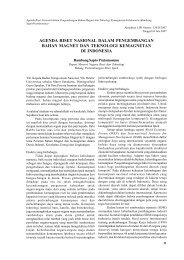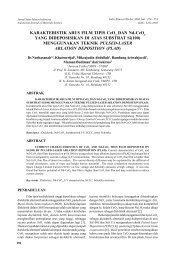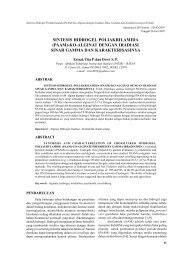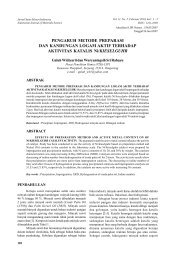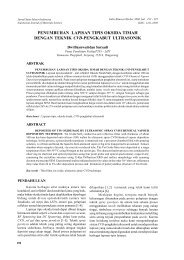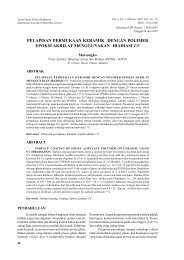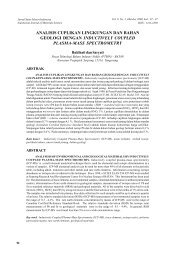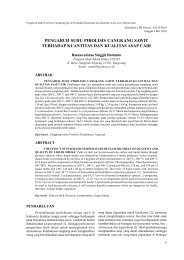degradation of sodium alginate by low energy ... - JUSAMI - Batan
degradation of sodium alginate by low energy ... - JUSAMI - Batan
degradation of sodium alginate by low energy ... - JUSAMI - Batan
You also want an ePaper? Increase the reach of your titles
YUMPU automatically turns print PDFs into web optimized ePapers that Google loves.
Degradation <strong>of</strong> Sodium Alginate By Low Energy Electron Beam (Tita Puspitasari)DEGRADATION OF SODIUM ALGINATEBY LOW ENERGY ELECTRON BEAMTita Puspitasari 1 , Naotsugu Nagasawa 2 , Toshiaki Yagi 2 and Fumio Yoshii 21Center for Research and Development <strong>of</strong> Isotopes and Radiation Technology - BATANP.O. BOX 7010 JKSKL, Jakarta 12070 Indonesia2Takasaki Radiation Chemistry Research Establishment - JAERIWatanuki, Takasaki, Gunma, 370-1292 JapanABSTRACTDEGRADATION OFSODIUMALGINATE BYLOWENERGYELECTRON BEAM. High viscosity(HV) and <strong>low</strong> viscosity (LV) <strong>alginate</strong> prepared in 5% solutions were irradiated <strong>by</strong> <strong>low</strong> <strong>energy</strong> electron beam(LEEB) at 55 o C and ambient temperature respectively. Oligo<strong>alginate</strong>s with molecular weight <strong>low</strong>er than20,000 Da and broad molecular weight distribution were obtained until 60 minutes <strong>of</strong> irradiation. The decreasein molecular weight was accompanied <strong>by</strong> appearance <strong>of</strong> UV absorbance peak at 265 nm. LV <strong>alginate</strong> waspreferable to use as raw material for LEEB irradiation process than HV <strong>alginate</strong>.Key words : Sodium <strong>alginate</strong>, <strong>degradation</strong>, radiation, <strong>low</strong> <strong>energy</strong> electron beamABSTRAKDEGRADASI NATRIUMALGINATDENGAN MENGGUNAKAN MESIN BERKAS ELEKTRONENERGI RENDAH. Alginat viskositas tinggi (HV) dan rendah (LV) dengan konsentrasi 5% diirradiasi denganmenggunakan mesin berkas elektron energi rendah (MBE - Energi Rendah) masing-masing pada suhu 55 o C dansuhu ruang. Setelah diiradiasi selama 60 menit diperoleh oligoalginat dengan berat molekul lebih kecil dari20.000 Da dan memiliki distribusi berat molekul yang lebar. Penurunan berat molekul disertai dengan penampakanpuncak aborbansi UV pada 265 nm. Alginat viskositas rendah lebih baik digunakan sebagai bahan baku padaproses iradiasi dengan menggunakan MBE - Energi Rendah dibandingkan dengan alginat viskositas tinggi.Kata kunci : Natrium alginat, degradasi, radiasi, mesin berkas elektron energi rendahINTRODUCTIONAlginate belongs to the family <strong>of</strong> linearAlginates have been used in wide range <strong>of</strong> commercialproducts as food, drinks, and pharmaceuticals and intextile industry as stabilizer, viscosifier and gellingagent[2]. Recently oligomers <strong>of</strong> <strong>alginate</strong> (oligo<strong>alginate</strong>)can be used for growth- promoter <strong>of</strong> the bifidobacteriaand plant [3-5]. Additionally, same oligomers enhanceplant germination and shoot elongation[6]It has been reported that <strong>sodium</strong> <strong>alginate</strong> can bedegraded <strong>by</strong> acid hydrolysis[7] or enzymatic [8]. On theother hand, radiation provides a more convenienttechnique for polysaccharides <strong>degradation</strong> [9].Although <strong>degradation</strong> <strong>of</strong> <strong>sodium</strong> <strong>alginate</strong> <strong>by</strong> gammaraystechniques has already been studied [10-12], <strong>sodium</strong><strong>alginate</strong> <strong>degradation</strong> <strong>by</strong> <strong>low</strong> <strong>energy</strong> electron beam(LEEB) has not yet been investigated.LEEB is a convenient radiation machine whichhas an advantage with respect to economy, safety,operational simplicity and versatility. In addition,comparing with high <strong>energy</strong> electron beam and gammarays,a self-shielded LEEB system needs much <strong>low</strong>erinitial investment. The disadvantage <strong>of</strong> LEEB is its limitedpenetration, but applications in various fields hasalready been reported [13]. The purpose <strong>of</strong> this researchwork is to study the <strong>degradation</strong> <strong>of</strong> <strong>sodium</strong> <strong>alginate</strong>irradiated <strong>by</strong> LEEB and evaluate with respect to viscosity,molecular weight, molecular weight distribution and colorchanges.EXPERIMENTALMETHODMaterialsIn the experimental work, <strong>sodium</strong> <strong>alginate</strong>powder (KimitsuALGIN B5) was purchased from KimitsuChemical Industries Co. Ltd., Japan. Viscosity <strong>of</strong>ALGINB5 solution (1% aq.) at 20 o C is 550 cP. The ALGIN wasirradiated to 25 kGy with gamma rays (10kGy/h) toreduce its solution viscosity. Viscosity <strong>of</strong> irradiatedALGIN solution (1% aq.) at 25 o C reduced to 15 cP. Theraw material is called high viscosity <strong>alginate</strong> (HV).Gamma-rays pre irradiated called <strong>low</strong> viscosity97
Jurnal Sains Materi IndonesiaIndonesian Journal <strong>of</strong> Materials Science<strong>alginate</strong> (LV). This material was used without furtherpurification. Other used chemicals were at technicalgrade <strong>of</strong> purity.IrradiationIn this study, <strong>sodium</strong> <strong>alginate</strong> solution wasirradiated with a 250 keV-10 mAelectron accelerator usinga vessel type irradiator. The irradiator was made <strong>of</strong>stainless steel and equipped with stirrer placed on thebottom <strong>of</strong> the vessel with the purpose to facilitatehomogeneous <strong>degradation</strong>. The amount <strong>of</strong> 14 liter <strong>of</strong> 5%HV solution was put into the reaction vessel andirradiated at elevated temperature (55 o C). LV wasirradiated at ambient temperature with various beamcurrent (mA) and irradiation time. The solution wasstirred throughout irradiation.Analytical ProceduresThe viscosity <strong>of</strong> <strong>alginate</strong> solutions wasdetermined at 25 o C <strong>by</strong> rotary viscometer (TV-20 TokimecCo Ltd., Japan).Irradiated samples were analyzed <strong>by</strong> GelPermeation Chromatography (GPC) for this purposeHLC-8020 (Tosoh Co. Ltd., Japan) instrument equippedwith three TSK gel PW XLcolumns (300 × 7.8 mm) inseries (G6000 PW XL, G3000 PW XLand G2500 PW XL;Tosoh Co. Ltd., Japan) was used in combination with aTSK guard column PW XL(40 × 6.0 mm).The f<strong>low</strong> rate <strong>of</strong>0.1 M <strong>sodium</strong> nitrate aqueous solution was 0.5 ml/min atthe temperature <strong>of</strong> 40 o C. The eluent was monitored <strong>by</strong>RI-8020 differential refractometer at 40 o C. Molecularweights were determined <strong>by</strong> use <strong>of</strong> calibration curve for0.1% (w/v) standards pullulan, poly (ethylene oxide) andpoly (ethylene glycol).UV-visible spectroscopy <strong>of</strong> irradiated <strong>alginate</strong>solution was performed at 25 o C using a Shimadzuspectrophotometer UV-265FW in the range <strong>of</strong>200-400 nm to determine the absorbance. The aqueoussolution consisting <strong>of</strong> 0.025 % (w/v) <strong>of</strong> polymer wasanalyzed.RESULTAND DISCUSSIONChange in Viscosity and Molecular Weight <strong>of</strong>Alginate SolutionAfter LEEB Irradiation.Alginate solutions with different viscositiesand weight average molecular weight (Mw) wereobtained after irradiation. 5% HV <strong>alginate</strong> solutionrequired heating during irradiation due to its veryhigh viscosity. In the case <strong>of</strong> <strong>low</strong> viscosity <strong>alginate</strong>solution (LV), the sample was irradiated without heating.In Figure 1 the viscosities <strong>of</strong> irradiated <strong>alginate</strong> solution<strong>of</strong> HV and LV are compared. There was gradual decreasein the viscosity <strong>of</strong> LV <strong>alginate</strong> solution. Even afterEdisi Khusus Oktober 2006, hal : 97 - 101ISSN : 1411-109820 minutes <strong>of</strong> irradiation, the viscosity <strong>of</strong> HV was stillover 5,000 cP, whereas that <strong>of</strong> LV reached around 20 cP.After about 40 minutes <strong>of</strong> irradiation, the viscosities <strong>of</strong>these <strong>alginate</strong> solutions reached saturation with a value<strong>low</strong>er than 5 cP. The initial viscosities <strong>of</strong> HV and LV<strong>alginate</strong> were over 5,000 cP and around 1,200 cP,respectively. It can be explained that sharp decrease inviscosities occurred in the first 40 minutes irradiation.The delayed reduction <strong>of</strong> HV <strong>alginate</strong> compared to LV<strong>alginate</strong> can be attributed to the in homogeneity <strong>of</strong>irradiation due to the higher viscosity <strong>of</strong> HV <strong>alginate</strong>.50403020100Vis. 0 min is1200 cPVis. 0 min is upto 5000 cPHVLV0 20 40 60 80 100 120Time (min)Figure 1. The decreased <strong>of</strong> viscosity <strong>of</strong> HV and LV<strong>alginate</strong> solution irradiated <strong>by</strong> LEEB (250 keV ; 10 mA)The initial Mw <strong>of</strong> HV and LV <strong>alginate</strong>s solutionswere ca. 1,100,000 Da and 300,000 Da respectively.Figure 2 presents average molecular weight (Mw) <strong>of</strong>irradiated <strong>alginate</strong> solutions. As seen from the figure,abrupt change in molecular weight was noted both forHV and LV <strong>alginate</strong> solutions. After irradiation for 40minutes at 10 mA, the viscosities <strong>of</strong> HV and LV werealmost the same but with different corresponding Mw.100000900008000070000600005000040000300002000010000Mw 0 = 306,000Mw 0 = 1,100,000HVLV00 20 40 60 80 100 120Time (min)Figure 2. The decreased <strong>of</strong> molecular weight (Mw) <strong>of</strong> HVand LV <strong>alginate</strong> solution irradiated <strong>by</strong> LEEB (250 kV).98
Degradation <strong>of</strong> Sodium Alginate By Low Energy Electron Beam (Tita Puspitasari)The Mw <strong>of</strong> HV <strong>alginate</strong> solution was <strong>low</strong>er compared tothat <strong>of</strong> LV <strong>alginate</strong> solution. This was probably due toheating at 55 o C not only facilitated mixing process inthe beginning <strong>of</strong> irradiation, but also enhanced the<strong>degradation</strong> process through thermal effect.The viscosities <strong>of</strong> irradiated LV <strong>alginate</strong> solution<strong>by</strong> various beam currents are shown in Figure 3.The viscosity <strong>of</strong> 5% <strong>alginate</strong> solution decreasedremarkably at the initial stage and then gradually leveled<strong>of</strong>f with time and beam current increase. The viscositydecreased remarkably after 10 minutes <strong>of</strong> irradiation withbeam current <strong>of</strong> 5 and 10 mA, whereas 20 minutes for 2.5mAwere needed to level <strong>of</strong> this parameter. The viscosities<strong>of</strong> the <strong>alginate</strong> solutions were measured for the samplesirradiated <strong>by</strong> 2.5 mA beam for 90 minutes; 5 mA for 50minutes and 10 mA for 35 minutes. Their viscositiesdecreased from 1,200 cP. to be<strong>low</strong> than 10 cP.14030 35 40 45 50 55 60Retention time (min)Control0 min10 min30 min60 minFigure 4. GPC elution curves <strong>of</strong> <strong>alginate</strong>s irradiated to 0,10, 30 and 60 minutes in aqueous solution.1201002.5 mA5 mA10 mA3503002.5 mA5 .0mA8025020010 mA6015040100205000 10 20 30 40 50 60 70 80 90 100Irradiation time (min)Figure 3. Effect <strong>of</strong> irradiation time and beam current onviscosity <strong>of</strong> LV <strong>alginate</strong> solution (5 g/100 mL) irradiated<strong>by</strong> LEEB (250 keV).GPC elution curves <strong>of</strong> control (raw material) andLV irradiated <strong>by</strong> LEEB with current <strong>of</strong> 10 mAfor 0, 10, 30and 60 min are presented in Figure 4. The peak <strong>of</strong> theelution shifted toward in the case <strong>of</strong> longer irradiation(sample), indicating chain scission <strong>of</strong> <strong>alginate</strong>. The samephenomena for <strong>alginate</strong> irradiated <strong>by</strong> 2.5 and 5 mA havebeen observed.Figure 5 shows the decrease <strong>of</strong> Mw <strong>of</strong>irradiated LV <strong>alginate</strong> <strong>by</strong> different beam current.Molecular weight decreased remarkably after10 minutes <strong>by</strong> 2.5 and 5 mA beam current, whereas lessertime was for the abrupt change in Mw at 10 mA.Then, decrease became <strong>low</strong>er if irradiation time increased.The Mw <strong>of</strong> sample irradiated at 2.5 mA for 90 minutes;5 mA for 70 minutes and 10 mA for 35 minutes were <strong>low</strong>erthan 20,000 Da.As expected, the viscosity and molecular weight<strong>of</strong> <strong>alginate</strong> decreased significantly after irradiation.00 20 40 60 80 100Irradiation time (min)Figure 5. Effect <strong>of</strong> irradiation time and beam current ondecreasing <strong>of</strong> Mw <strong>of</strong> LV <strong>alginate</strong> solution (5 g/100 mL)irradiated <strong>by</strong> LEEB (250 keV).Similar results were also obtained for other irradiatedpolysaccharides such as carrageenan [14], citruspectin [15], agar [16] and chitosan [17]. Alginate hasglycosidic linkage similar with others polysaccharidesmentioned above. These polymers are typicalcondensation polymers degradable through random<strong>degradation</strong> process. In random <strong>degradation</strong>, molecularweight drop rapidly at the beginning and then remainsconstant [18]. In some polymers, radiation inducedrandom <strong>degradation</strong> and supposed that there is little orno monomer is produced even after extensive main chainfracture. Each monomer unit is equally liable to fractureafter absorbs <strong>energy</strong>. The reported that there is no bigdifference in the depolymerization <strong>of</strong> chitosan forirradiation dose <strong>of</strong> 100 and 200 kGy 17 . As it wasestablished previously, irradiation induced scission <strong>of</strong>1-4 glycosidic bonds <strong>of</strong> polysaccharides. In this99
Jurnal Sains Materi IndonesiaIndonesian Journal <strong>of</strong> Materials Scienceexperimental work, it is evident that LEEB irradiationinduced <strong>degradation</strong> <strong>of</strong> <strong>alginate</strong> through chain scission<strong>by</strong> random <strong>degradation</strong> process. The <strong>degradation</strong>process is fast <strong>by</strong> using 10 mA <strong>of</strong> beam current.The molecular weight distribution for HV and LVirradiated <strong>alginate</strong>s are shown in Figure 6.Edisi Khusus Oktober 2006, hal : 97 - 101ISSN : 1411-10984035302520HVMVFigure 7. Color change <strong>of</strong> <strong>alginate</strong> solution irradiatedusing LEEB (250 keV; 10 mA) ( = upper level <strong>of</strong> thevessel = bottom level <strong>of</strong> the vessel).15100.75500 20 40 60 80 100 120Time (Min)Figure 6. The molecular weight distribution <strong>of</strong> HV andLV <strong>alginate</strong> solutions (5g/100 mL) irradiated <strong>by</strong> LEEB(250 kV).0.500.250 m inutes40 m inutes60 m inutesAt the initial stage <strong>of</strong> irradiation, the molecularweight distributions <strong>of</strong> <strong>alginate</strong> are broad suggestingtime dependent <strong>degradation</strong>. The narrow distributionwas reached after 40 minutes <strong>of</strong> irradiation. It can beexplained that at initial stage, <strong>alginate</strong> was degraded onlyon the surface. Some part <strong>of</strong> <strong>alginate</strong> still unirradiatedbecause the solution was still viscous. With increase inirradiation time, more <strong>alginate</strong> degraded due to <strong>low</strong>erviscosity <strong>of</strong> the solution and after the time mentionedabove, whole volume <strong>of</strong> solution was degradedhomogeneously.ColorChange <strong>of</strong>Alginate Irradiated By LEEBThe color change was evaluated on the base <strong>of</strong>UV absorbance. Figure 7 shows the photographs <strong>of</strong><strong>alginate</strong> solution samples irradiated <strong>by</strong> 10 mA beam for5 and 60 minutes. The color became more intense brownin the case <strong>of</strong> samples irradiated for 60 minutes. Figure 8shows the UV spectra <strong>of</strong> <strong>alginate</strong>s irradiated for 40 and60 minutes: a new absorption band at 265 nm wasobserved. The intensity <strong>of</strong> the peak increased for longerirradiation time. Figure 9 shows the difference <strong>of</strong> opticaldensity <strong>of</strong> HV and LV <strong>of</strong> <strong>alginate</strong> solution irradiated <strong>by</strong>LEEB (250 keV; 10 mA).TheOD <strong>of</strong>irradiated HVis higherthan that <strong>of</strong> irradiated LV. The same result was alsoobserved in the case <strong>of</strong> HV irradiated <strong>by</strong> gamma rays atelevated temperature.Nagasawa et al (2000) observed a newabsorption band at 265 nm for <strong>alginate</strong> irradiated <strong>by</strong>gamma rays and proposed that color changeoccurred due to double bond formation <strong>by</strong> chainscission [12]. As it is already known, irradiationchanges the chemical structure <strong>of</strong> material. It can beexplained that in the case <strong>of</strong> <strong>alginate</strong> solution irradiated0.00200 250 300 350 400 450 500W avelength (n m )Figure 8. UV spectrum <strong>of</strong> <strong>alginate</strong> solution irradiated 0,40 and 60 minutes using LEEB.<strong>by</strong> LEEB, the decrease in molecular weight isaccompanied <strong>by</strong> changes <strong>of</strong> the chemical structurewhich resulted changes <strong>of</strong> color. The color <strong>of</strong> irradiatedHV was more intense than that <strong>of</strong> irradiated LVprobably because <strong>of</strong> thermal effect <strong>of</strong> 55 o C duringirradiation <strong>of</strong> HV.Conversion <strong>of</strong> IrradiationTime <strong>of</strong> LEEB WithIrradiation Dose <strong>of</strong> LEEBAs it was mentioned before, irradiation usingLEEB is supposed to be more feasible and economicthan those with a Co-60 or with a medium and high <strong>energy</strong>electron accelerator. However LEEB has disadvantagessuch as <strong>low</strong> penetration, high absorption and widescattering in air. According to Makuuchi, K. (to bepublished) [20], <strong>energy</strong> lost from the window duringirradiation <strong>by</strong> LEEB is around 30%. Then, with 12.5 cmthickness <strong>of</strong> air; only 40% <strong>of</strong> the <strong>energy</strong> remains wasabsorbed <strong>by</strong> samples. Estimation <strong>of</strong> the dose absorbedin irradiated samples was based on the equation:1 kGy = 1 kJ/kg = 1 kWs/ kg = (1 keV × A)s/kgThe <strong>energy</strong> consumed for 60 minutes irradiation <strong>by</strong> LEEB(250 keV; 10 mA) is:250 keV × (10 × 10 -3 A) × (60 min × 60 sec/min) =(9 × 10 3 ) kWsIn this experiment, 14 L <strong>of</strong> LV <strong>alginate</strong> solution samplerelated to 15 kg.100
Degradation <strong>of</strong> Sodium Alginate By Low Energy Electron Beam (Tita Puspitasari)The absorbed dose <strong>by</strong> 15 kg <strong>of</strong> LV <strong>alginate</strong> solution is:0.4 × 0.7 × (9 × 10 3 ) kWs / 15 kg = 168 kGyThe irradiation time <strong>of</strong> LEEB (250 keV; 10 mA) with 15 kg<strong>alginate</strong> solution was converted to dose (kGy).The estimation dose presents on Table 1.Table 1. The estimated value <strong>of</strong> dose absorbed <strong>of</strong> 15 kg <strong>alginate</strong>solution irradiated <strong>by</strong> LEEB (250 keV;10 mA).Times (minutes) Times (second) Dose (kGy)CONCLUSIONOligo<strong>alginate</strong>s with molecular weight <strong>low</strong>er than20,000 Da. and broad molecular weight distribution wereobtained <strong>by</strong> LEEB irradiation. The decrease in molecularweight was accompanied <strong>by</strong> appearance <strong>of</strong> UVabsorbance peak at 265 nm. LV <strong>alginate</strong> was preferableto use as raw material in LEEB irradiation process thanHV <strong>alginate</strong>. Degradation <strong>of</strong> <strong>sodium</strong> <strong>alginate</strong> <strong>by</strong> LEEBinduces time dependent <strong>degradation</strong>.ACKNOWLEDGEMENTMs. Tita Puspitasari is grateful to MEXT, Japanfor the fel<strong>low</strong>ship. The author would also like also tothank Dr. Keizo Makuuchi <strong>of</strong> EB System Company andDr. N.Q. Hien <strong>of</strong> VietnamAtomic Energy Commission forvaluable discussions and suggestions.REFERENCES0 0 05 300 1410 600 2815 900 4220 1200 5625 1500 7030 1800 8435 2400 11240 3000 14050 3600 16860 4200 196[1]. GASECA, P., Carbohydrate Polymers, 8 (1988)161-182[2]. ERTESVÅG, H.; VALLA, S., Polymer Degradationand Stability, 59 (1998) 85-91[3]. AKIYAMA, H., ENDO, T., NAKAKITA, R.,MURATA, K., YONEMOTO, Y., OKAYAMA, K.,Biosci. Biotech. Biochem, 56 (1992) 335-356[4]. HIEN, N.Q., NAGASAWA, N., THAM, L.X.,YOSHII, F., DONG, V.H., MITOMO, H.,MAKUUCHI, K., KUME, T., Radiat Phys Chem, 59(2000)97-101[5]. KUME, T., NAGASAWA, N., YOSHII, F., RadiatPhys Chem, 63 (2002) 625-627[6]. YONEMOTO, Y., TANAKA, H., YAMASHITA, T.,KITABATAKE, N., ISHIDA, Y., KIMURA, A.,MURATA, K. Fermt Bioeng, 75 (1) (1992) 68-70[7]. HAUGH, A., MYKLESTAD, S., LARSEN, B.,SMIDSROD, O., Acta Chem Scand, 21 (1967)691-790[8]. SHIMOKAWA, T., YOSHIDA, S., TAKEUCHI, T.,MURATA, K., ISHII, T., KUSAKABE, I., BiosciBiotech Biochem, 60 (9) (1996) 1532-1534[9]. WOODS, R.T., PIKAEV, A.K., Applied RadiationChemistry: Radiation Processing 1994 , Wiley, NewYork, (1994) (Eds)[10]. KING, K. Food Hydro, 8(2) (1994) 83-96[11]. PUEWANTO, Z. I.,V.D., BROEK, L.A.M., SCHOLS,H.A., PILNIK, W., VORAGEN, A.G.J., ActaAlimentaria, 27 (1998) 29-42[12]. NAGASAWA, N., MITOMO, H., YOSHII, F.,KUME, T., Polymer Degradation and Stability, 69(2000)279-285[13]. KUME, T., Outline project on application <strong>of</strong>electron accelerator, Proceeding <strong>of</strong> The FNCAWorkshop on Application <strong>of</strong> Electron Accelerator ,Takasaki, Japan, (2003) 3-8[14]. KUME, T., TAKEHISA, M. Agric Biol Chem, 47(4)(1983)889-890[15]. ZEGOTA, H. The Food Hydrocolloids, 13 (1999)51-58[16]. ALISTE, A.J., VIEIRA, F.F., DEL MASTRO, N.L.,Radiat Phys Chem, 57 (2000) 305-308[17]. CHOI, W.S.,AHN, K.J., LEE, D.W., BYUN, M.W.,PARK, H.J., Polymer Deg Stab 2002, 78 (2002)533-538[18]. BILLMEYER, F.W. Textbook <strong>of</strong> Polymer Chemistry,Intersci Publs Inc, NewYork, (1957) 273-277[19]. CHARLESBY, A. Atomic Radiation and Polymers,Pergamon Press LTD, London (1960)[20]. MAKUUCHI, K. An Introduction to RadiationVulcanization <strong>of</strong> Natural Rubber Latex, to bepublished, EB System Corp, Takasaki, Japan101



